The Reason for and Prevention of Bulk Bag Overhang
April 23, 2019

Bulk bags, or FIBCs, are thought to be low-technology packaging. Users ignore many handling issues with bulk bags, wrongly thinking there are no alternatives. In most cases, the problems with bulk bags are solvable.
One current trend is a desire to have bags without “overhang.” That is, bags that are no wider than the pallet. Users fear that overhang will create damage to the packaging and therefore the product in the packaging.
When bag users use the term “overhang,” there are two possible definitions. The overhang can either refer to the belly of the bag being wider than the pallet, or the bag itself hanging down below the top edge of the pallet. The first version can lead to the second version if the bag is not designed and filled properly. The bag hanging below the top edge of the pallet is definitely an issue that needs to be prevented.
Let us look at both versions in more detail.
A bag that sags below the top edge of the pallet can be damaged by the forklift tines. The sagging bag can block the pallet opening, allowing the forklift tines to pierce the bag. The sagging portion of the bag can also be damaged by adjacent pallets while moving them into place.
If the bag is sagging over the edge of the pallet, it is also likely leaning significantly. This lean increases the odds of the bag falling over or the bag getting snagged on something outside of the expected width of the bag and pallet. When the operator places the bag on the pallet, it is likely completely vertical. Through bag and product movement, a bulk bag can develop a leaning stance. Once movement begins, the bag can move back and forth, creating opportunities for abrasion damage. Preventing these occurrences is an important aspect of package design and handling. The best prevention is a design that allows the bag to be supported by neighboring bags and walls.
The other version of overhang is more complicated. In fact, it can be argued that the bag being wider than the pallet is actually desirable. Unless there are specific, very demanding racking requirements, the overwhelming majority of the time a wider bag is better than a narrower bag. Yes, this is counterintuitive, but that does not make it wrong.
The hesitancy to use bags that are wider than the pallet comes from the idea that contact of the bags with either the trailer walls or other bags creates problems. Contact with those surfaces usually results in damage only if the bags can move during transport. This can happen only if the bags are not supported during transport. If a bag is in contact with other bags and walls on all four sides, there is unlikely to be enough friction to create damage.
This is similar to buying a new pair of shoes. If the shoes are too large, your foot will move and rub against the shoe, causing blisters. When your foot fills the shoe completely, it cannot move and will not develop blisters.
A standard pallet is 40 by 48 in. Imagine a load of bulk bags on a truck. Then imagine removing the bags from the pallets. There will be huge gaps between the pallets. If you drive the truck with the pallets, but without the bags, the pallets will move all over the floor of the truck because nothing is holding them in place. Repeating the same exercise with pallets that fill the width of the truck will result in no movement or damage during transport.
We should view bulk bags in the same manner. The bulk bag should fill the entire width of the truck without any gaps that would allow movement. Because the bags support each other, preventing lean, the arrival condition of the entire load is improved.
If the bulk bag’s belly is wider than the pallet, the belly acts as a buffer to prevent pallets from snagging other bags as they are being moved or loaded into trucks. The math is easy. The pallet is 40 in. wide. The bag is 47 in. in diameter. If bags are loaded side by side in a truck, there are seven inches between each pallet if the bag bellies are touching, providing a large buffer.
Despite the advantages of using bulk bags that are wider than the pallets on which they rest, there are issues that need to be addressed. Unless you are using a baffle bag, your bag forms a cylinder. Even U-panel bags, despite the optical illusions created by the side seams, form cylinders. For example, a 37 by 37 in. base bag will form a cylinder that is 47 in. in diameter when filled, creating 3.5 in. of overhang per side at the belly of the bag. To prevent the belly of the bag from extending past the pallet, the base size would have to be reduced to 29.5 in. by 29.5 in. Narrowing the bag that drastically requires a significant height increase. A 37-in. square bottom bag that is 45 in. tall would require a change to 29.5 in. by 29.5 in. by 70 in. tall. Such a bag would be wildly unstable and would also completely eliminate the ability to maximize overland and overseas freight.
Even with a baffle bag, there is still a rounding effect, but the effect is limited to each cell portion of the bag. The corners are basically 270 degrees of a cylinder. If you look closely at a baffle bag, there is pillowing across each side of the bag. Each of these pillowed sections extends out 2 to 3 in. at the vertical center.
The instability of narrow bags would create a truckload of narrow pillars leaning in random directions throughout the trailer. Bulk bags are flexible packages. While that flexibility offers many benefits, unfortunately, the bags want to change shape and direction. The lean created by narrow bags can create a situation where part of the bulk bag hangs down over the edge of the pallet. If the bags are wide enough to touch neighboring bags or walls on all four sides, the contact prevents this.
The other method of managing overhang is to properly design the bag so that the bag is completely full. Doing this eliminates the empty space that the product in the bag requires to move or lean. To verify that your bag is filled completely, lift the bag by the loops. If you see empty space at the top of the bag when it is suspended, your bag is not completely full and has the potential to lean. To address this, ask your bulk bag supplier to revise your specification.
Last, if the bottom of the bag is shaped more like the belly of the bag, then overhang will be minimized because the bag will better be supported by the bottom of the bag. This can come in the form of an octagon or a circle. The danger with a round bottom is if the bottom is actually, unintentionally, shaped like an egg. A bottom that approximates a circle using short straight lines creates a more consistent shape.
The ideal bulk bag design to prevent the bag from sagging down past the top edge of the pallet is the widest bag your shipping method allows, the shortest bags you can get completely full, and the bag bottom that makes the most efficient use of its perimeter. Because bulk bags are flexible packages, proper design and use are vitally important. Design decisions need to be based on the physics of the packaging type. Your bulk bag supplier should be able to help with these design challenges.
Daniel R. Schnaars Jr. is vice president, AmeriGlobe LLC, and holds two of their numerous bag design patents and patents pending. AmeriGlobe has been providing bulk bag solutions for more than 30 years. For more information, call 866-264-5623 or visit www.ameriglobe-fibc.com.
For related articles, news, and equipment reviews, visit our Packaging & Bagging Equipment Zone
Click here for Packaging & Bagging Equipment Manufacturers
Get information or register for Powder Show Toronto, June 4-6, 2019
You May Also Like

